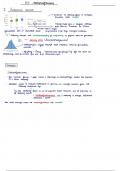Samenvatting
Summary Host response to biomaterials (8MM50)
Samenvatting van alle colleges van het vak Host response to biomaterials, inclusief gastcollege 2 (=lecture 7) en gastcollege 4 (=lecture 12). Exclusief gastcollege 1 (=lecture 6) en gastcollege 3 (=lecture 9) aangezien deze twee colleges geen tentamenstof zijn.
[Meer zien]













